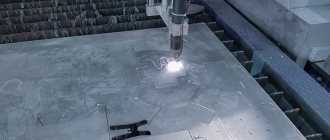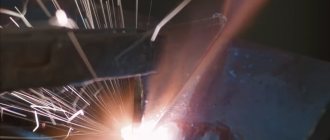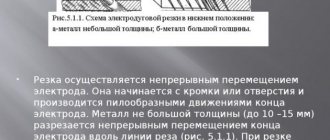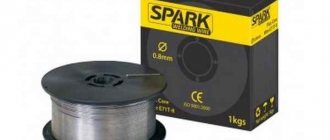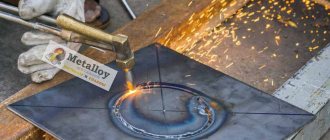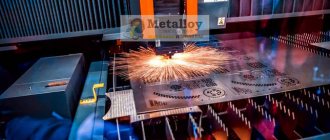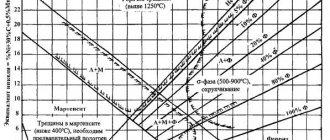Essence of the process
At the moment of formation of the oxygen stream, flux, most often iron powder, is slowly and continuously supplied. When burned, the powder releases the necessary additional amount of heat, thereby increasing the cutting temperature range. This method allows the formed oxides not to harden. Oxygen cutting using flux is used for:
- • high-alloy steels containing chromium and nickel, the components of which during the welding process form refractory oxides that are not eliminated by an oxygen jet;
- • work with cast iron and non-ferrous metals that are sensitive to temperature fluctuations.
Types of fluxes - iron and aluminum powders, quartz sand, silicocalcium and ferrosilicon - ceramic fluxes (for low-alloy steel), ferrophosphorus (for cast iron).
Composition of fluxes
The basis of flux additives is metal powder with a fraction size of no more than 0.2 mm. For a sustainable metal separation process, the carbon content in the powder should not exceed 0.4% and oxygen - 6%. Exceeding these values contributes to a decrease in combustion temperature, which leads to an undesirable scenario. When using oxygen-flux cutting in accordance with the requirements of the industry standard GOST 9849-74, 5 standard grades of flux iron powder PZh-1 - PZh-5 are used. In addition to iron, which accounts for 94% to 98% of the total, fluxes include components such as silicon, phosphorus, carbon, sulfur and manganese. In addition, fluxes can be used, which, in addition to iron powder, contain additives in the form of aluminum particles. The quality of fluxes is determined by the size of the powder elements, which should not exceed 0.28 mm. To do this, during the production process, the components are screened through a special sieve. In the presence of large fragments, the flux may flow unevenly into the working area, as a result of which the normal course of the exothermic reaction of metal cutting will be threatened.
Types of oxygen-flux cutting
Oxygen-flux cutting technology processes metals with the pressure of a gas flame mixed with a stream of oxygen, which performs the function of a “cutting flame.” In this way, cutting durable metals can be done both manually and mechanically. For automatic oxygen-flux cutting, gas-cutting devices are used in which cutters are installed. Using the machines, the master can make surface cutting or separation. When cutting manually, special holders are used, in which gas and oxygen are also supplied under pressure. Both manual and machine methods can process high-strength metals up to two hundred millimeters thick at high speed (about 300-700 mm/min).
Where is oxygen flux separation cutting used?
Spear cutting technology is actively used at metallurgical plants, heavy engineering enterprises, etc. It is used to cut scrap metal and surplus materials, cooled blooms, trim profits, surface cutting and cutting of defects on castings, and burn holes in reinforced concrete and concrete products.
Photo 5. Cutting scrap metal at the copra site
However, you should know that the quality of the cut when using this method is low, so it is used where high-quality edges are not required or other cutting options are impossible.
← Automatic plasma cutting of metal What is a water plasma torch →
Devices for oxygen-flux processing of metals
Processing of metal products using the oxygen-flux method is carried out using special devices. The design of the device includes such elements as a cutter, a flux feeder, and a flux transmitter into the cutter. The metal-cutting tool in the device has a larger diameter compared to a similar device for cutting only with oxygen. Oxidizers, propane, nitrogen, flux-carrying gases, and CO2 act as combustible raw materials. The spear holder “KD-1” helps in the manual cutting process. Machine cutting with flux and oxygen is carried out on portal automatic devices and UKFR-6M installations. Devices for manual and automatic cutting process materials such as steel, cast iron, concrete, aluminum, and various non-ferrous alloys.
The essence of the method
Oxygen-flux cutting in some cases may be the only possible way to process the product. Cutting is performed using special CNC machines, which are equipped with software that allows for high precision of the operation. They perform almost jewelry processing of the workpiece and are used not only for cutting metal products, but also for welding thermocouples, soldering ampoules, local annealing and other operations.
The essence of the operation is the introduction of powdered flux into the cutting oxygen flow. The flux burns and significantly increases the temperature in the cutting area. A chemical reaction occurs: the combustion products of the powder combine with refractory oxides. As a result of this, waste is formed. They do not interfere with the cutting process and are easily removed from the cutting area with a stream of oxygen.
The process of oxygen-flux cutting of high-chromium steels
Products made of high-chromium and chromium-nickel steel cannot be treated with oxygen alone due to the fact that, when oxidized, chromium becomes refractory and is difficult to remove from the cut of the workpiece. For such materials, oxygen-flux cutting technology was invented. Steel blanks with a high chromium content are cut with a stream of oxygen to which powder (flux) has been added. The powder substance burns when it comes into contact with oxygen, the heat output increases, and the chromium steel begins to melt exactly at the cutting points. Working using this technology produces a clean cut surface.
Hardware component
Equipment for cutting using this technology structurally consists of the following units:
- Flux feeder – is a container for flux.
- A cutter is a cutting tool with an oxygen lance.
Photo 2. Diagram of a working station for oxygen-flux cutting
The standard post should also include hoses for supplying oxygen and flux powder from the flux feeder, air and oxygen reducers, cylinders with compressed air (can be replaced with a compressor) and oxygen.
Photo 3. Appearance of the spear holder
Oxygen-flux cutting of cast iron
Cast iron products melt at very high temperatures, so the oxygen fluxing process is also used for cast iron. Oxygen cutting is not suitable due to the fact that cast iron contains silicon, which forms a durable film under the influence of CO2. You can melt it to get a neat cut on the product only with the addition of flux powder. Oxygen-flux cutting of cast iron prevents contamination of the oxygen stream and prevents oxidation from occurring at the cut sites.
Oxygen cutting of high alloy steels
Various methods for cutting high-alloy steels are known, some of them are successfully used in practice. These methods are characterized by the use of local heating with the expenditure of a significant amount of energy and loss of mass of the processed metal due to its oxidation (combustion) or melting.
In table 1 shows the main cutting methods, energy sources used for this purpose, and the maximum thickness of the metal being cut.
Table 1. Method of cutting high-alloy steels
| Cutting method | Energy source | Maximum thickness of cut metal, mm |
| (Air-arc | Electric arc | 30 |
| Oxygen-arc | 120 | |
| Plasma-arc | Same thing, gas jet | 300 |
| Oxygen-flux | Gas-oxygen flame and flux | 1000 |
High-alloy steel with a high chromium content can be cut by introducing special fluxing additives into the reaction zone or mechanically removing the oxide film from the cut site. This cutting method is called oxygen-flux, and the materials introduced into the cut are called fluxes. Greater stability of the process is achieved by continuously introducing a steel bar or strip into the cut.
In this case, the heat released during the combustion of a rod (or strip), as well as molten iron and its oxides passing into the slag, contribute to the liquefaction of chromium oxides and their removal from the cut. This method can cut steel up to 400 mm thick.
The disadvantage of this cutting method is the need to use two workers, one of whom must continuously feed the rod into the cut at high speed. In addition, cutting high-alloy steels requires a high-power preheating flame, since the amount of heat expended on this significantly exceeds the amount of heat for cutting low-carbon steel of the same thickness. As a result, a large cut width, poor surface quality and low cutting speeds are obtained.
Air-arc and oxygen-arc methods of cutting high-alloy steels have become somewhat widespread. However, the most effective methods for cutting high-alloy steels and alloys are plasma-arc and oxygen-flux.
From a comparison of various cutting methods, we can conclude that air-arc and oxygen-arc cutting are low-productive (Fig. 1)
Rice. 1. Dependence of the cutting speed on the thickness of the steel X18N10T being cut and the cutting method: 1 - plasma-arc; 2 - oxygen-flux; 3 — air-arc; 4 — oxygen-arc
The disadvantage of air arc cutting is the large width of the cut, determined by the diameter of the electrode, as well as a significant proportion of auxiliary time in the overall balance of cutting time due to frequent changes of electrodes. However, in some cases, due to the simplicity of this process, its use is advisable.
Oxygen-arc cutting is determined by the thickness of the steel being cut (up to 120 mm).
The advantage of this method is high cutting speed , which is achieved by heating the cutting oxygen with the heat generated by the electric arc, as well as due to the combustion of hot electrode particles. However, the high cost of the steel tubular electrodes used for this cutting and significant melting of the upper edges of the sheet being cut, which requires additional mechanical processing of the cut surface, limits the use of oxygen-arc cutting.
It is more productive to cut thin steel with plasma. As the thickness of the metal being cut increases, the speed of plasma-arc cutting decreases. For cutting steel with a thickness of more than 40 mm, it is more productive to use oxygen-flux cutting. The latter is explained as follows.
Plasma arc cutting is characterized by a point nature. Here, the heat is mainly spent on heating the surface layers of the metal being cut. Therefore, the depth of heat penetration is limited. The high costs of equipment for plasma arc cutting and energy consumption make it difficult to implement this cutting method for processing medium-thick steels.
In oxygen-flux cutting, as a result of a self-sustaining reaction, the product is cut to its full depth; the main amount of heat is obtained due to the combustion of steel in oxygen. Cutting continues until oxygen enters the reaction space and oxidation products are removed.
- Back
Oxygen-flux cutting of non-ferrous metals
The difficulty of processing non-ferrous metals (such as brass, bronze, copper alloys) is the high thermal conductivity of these materials. Oxygen does not generate enough heat to cope with non-ferrous metal parts. Cutting non-ferrous metals with oxygen and flux is done by adding a substance - ferrophosphorus - to the powder. In addition, the cutting process begins only after preheating to 300-400 degrees Celsius. When working with oxygen-flux technology, craftsmen wear respiratory masks, since the substances released during the process are harmful to humans.
Features of using the oxygen-flux technique
The main difficulty in the process of cutting high-alloy steel is the presence of refractory oxides. The presence of a film on the oxidation products eliminates normal contact between the cutting site and the oxygen stream, contributing to an increase in the volume of heat removed from the process site, which leads to the completion of the operation. Metals, during the cutting of which a refractory film is formed on the oxides, include stainless steels, heat-resistant steels, cast irons and many others. To successfully implement the process of cutting them, it is necessary to ensure the melting of the oxides and their removal from the working area. In this case, combustion products must be in the required liquid state. This can only be done by using additional heat concentrated at the cutting site. This effect is achieved through the use of a special flux, which is supplied into the cutting slot along with oxygen and flammable gas, which ensures the functioning of the preheating flame. At the same time, the powdered material acts as a catalyst for the process with the necessary thermal and abrasive effects. The metal powder burns in the cutting gap and thereby increases the temperature in the given working area, providing the necessary degree of fluidity of refractory oxides. At the same time, thanks to the additional thermal effect, the lower layers of the metal are heated, which are subsequently cut. When using oxygen-flux technology, metal is cut with a maximum thickness that can reach 500 mm. The abrasive function of the flux additive consists of a mechanical effect under the guise of impact friction of catalyst particles on products in the form of refractory oxides. The cutting speed depends on the thickness and chemical composition of the material.
Metalworking ordered from our company is carried out in the shortest possible time!
Why do you order oxy-fuel cutting from us:
- Creation of products from 1 hour
- Deferred payment to regular customers
- Payment upon delivery is possible
- Product quality complies with GOSTs, TUs and is confirmed by certificates
Placing an order
To find out the exact prices for services or place an order for oxygen-flux cutting, you can contact us by phone +7 (903) 720-02-17, or by email [email protected] You can also fill out the feedback form on the website, and our specialists will call you back shortly.
Among other things, you can place an order for the production of metal products in our office at the address: Pokhodny Proezd, 23, room II, room. 7, floor 2. We are open Monday to Friday from 10.00 to 17.00.
